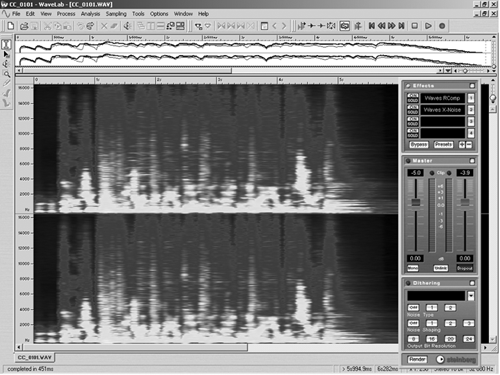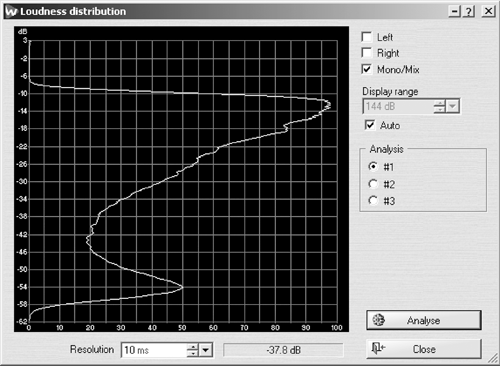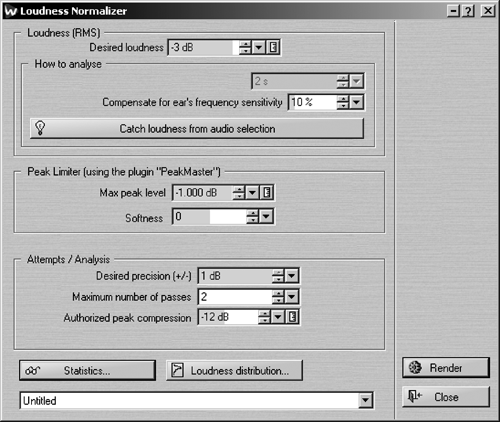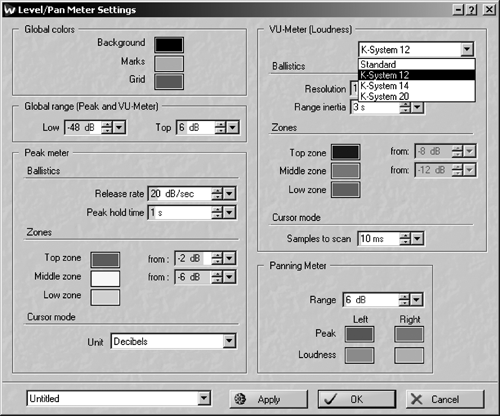
By Steve Cunningham
I’ve been using WaveLab once a week for years to edit half-hour radio shows and to master CDs, and lately it has been pressed into service to edit assorted podcasts. Since its introduction in 1996, Steinberg has continued to update WaveLab, popping out a major revision every couple of years. Each new version seems to bring new tools and features to the program, without ever sacrificing stability or performance.
For those of you already using WaveLab, version 6 adds several new features to a stereo editor that already has more functions than most will use. However, the new functions are not just eye- or ear-candy, but serious productivity-enhancing tools. For those of you who haven’t yet checked out what I think is the best stereo editor on the market, it’s high time (for a look at version 5, see the January 2005 issue of RAP). WaveLab is a PC-only stereo editor that comes with a broad selection of plug-ins, a 32-bit floating point audio path for maximum internal headroom, the ability to create DVD-A discs, an Audio Montage function that lets you record up to eight simultaneous tracks and play an unlimited number, and an 800-page manual to describe it all.
WaveLab’s requirements are little-changed since version 5. It needs a minimum Pentium III at 800MHz, 256MB of RAM, and either Windows XP or 2000. You will want a 2.4GHz Pentium IV and a gig of RAM for best performance, and of course a large hard disk. The extra RAM helps speed up processing; actual audio editing is disk-based so the size of audio files is not limited by RAM. You will also want a multichannel audio interface with ASIO drivers, especially if you want to use the multichannel capabilities of WaveLab.

FIRST THE BAD NEWS
There is one new feature that may not please some, and that’s the addition of a USB dongle as copy protection. The full version of WaveLab comes with the same Synchrosoft USB dongle that is included with Cubase SX and Nuendo, which means that if you own a “dongled” Steinberg product, you can add a WaveLab license to that dongle using a simple online form. But WaveLab users who upgrade from version 5 or earlier will need to purchase a dongle for an additional $30. Those of you who have read this column for awhile know how I feel about losing the use of another USB port, so I won’t belabor the issue.
The upgrade process is otherwise simple but not necessarily painless. The version 6 upgrade requires that you have both your earlier version CD and serial number close at hand when you purchase and install the upgrade. I had one slight problem — the only place to find the serial number is on the outside of the glossy cardboard box that contained my version 5 CD and manual. Who keeps the cardboard box? I certainly don’t, so all I had was the CD and an activation key (which is not the same as the serial number). A call to the sales department at Steinberg US gave me the serial number I would need to finish the installation. When the upgrade came I was careful to cut the serial number off the box and store it in the manual.

NOW THE GOOD NEWS
All the cool tools from previous versions are still there, including high-quality audio scrubbing and assignable key commands, so let’s start with the new stuff. The most noteworthy addition to WaveLab has to be the two new display modes. In addition to the familiar wave display, you can now choose to view audio in Spectrum or Loudness Envelope modes. Spectrum shows a spectrographic image with frequency on the vertical axis and intensity represented by color, and a Spectrum editor allows you to define and select specific frequency regions for editing.
What’s more, you can view the frequency content in color with the most intense frequency ranges in yellow and the least intense in blue, or you can view the entire thing in grayscale. You can change the vertical scale of frequencies from logarithmic to linear, and scale the color range in such a way that only the loudest frequencies show brightly. This is great for highlighting troublesome transients.
The Loudness Envelope displays a graph of RMS loudness over time for the overall signal, as well as within three definable frequency bands. Besides presenting loudness more accurately than the waveform, the Loudness Envelope shows you areas that have likely been compressed. Both these displays are independent in the overview and main windows, so one can choose to view Loudness Envelope in the overview window and Spectrum in the main window.

SURGICAL EDITING
Together these two modes make quick work of cleaning up audio. The Spectrum option is particularly useful because it shows things that may not be visible in any other view, and the editor allows for surgical removal. For example, low rumble due to air conditioning is usually visible as a line running through the Spectrum view. With the Spectrum selector you can select a portion of that line that appears in a quiet passage, and extend that selection through the entire audio file.
The selected noise can be “damped” or filtered out in the editor with a linear phase filter whose slope is variable up to 96 dB per octave, or can be set to “infinite” which Steinberg says gives a slope in excess of 1000 dB/octave. The selection can also be faded out and back in for a more subtle approach. By adjusting the crossfade time, WaveLab smoothes out the areas where the filtered audio meets the unfiltered. The results are every bit as good as I get using a broadband noise reduction plug, but without the artifacts.
The Loudness Envelope shows vocal plosives quite clearly for editing, and the Spectrum editor takes care of those as well. By editing the lower frequencies only, nasty P- and T-sounds can be tamed without affecting the intelligibility of the audio. Adobe Audition has had spectral editing since version 1.5, but my experience is that WaveLab’s version works better on plosives.
Both Spectrum and Loudness Envelope modes completely recalculate the display when you scroll or zoom. This process can be slow, especially when working with long audio files. To avoid this, switch to the Wave view before scrolling or zooming, then switch back to Spectrum or Loudness Envelope mode. The default key commands for Wave, Spectrum, and Loudness Envelope modes are 1, 3, and 5 on the upper keyboard row, so this quickly accomplished.
ENHANCED PROCESSING TOOLS
Several of WaveLab’s DSP functions have been enhanced in version 6, and a few new ones have been added. Keep in mind that both old and new DSP processes can be assigned to work in a Batch Processing mode, allowing you to process, rename, and even encode a folder full of files automatically.
The new Loudness Distribution window plots loudness levels by incident rather than by an average. This gives you a graph of what levels exist in your file, and how often each appear. A compressed audio file will yield a graph with a large lobe around the compression threshold, while an uncompressed file will be more evenly distributed.
WaveLab’s old Normalize process has been renamed Level Normalizer, making room for the new Loudness Normalizer. This process works with RMS levels instead of peaks, and uses the program’s PeakMaster limiter to tame transients while the process normalizes the RMS loudness. As a result, it is far more useful than regular normalization, which simply raises the entire volume until the loudest peak reaches max level.
The new Pan Normalizer is a close cousin to the Loudness Normalizer. This process will balance the left and right levels using either peak or RMS levels. This works well for leveling stereo sound effects that are significantly louder on one channel than on the other, without simply turning them into mono files.
With version 6, WaveLab has included K-System metering options to all of its VU and PPM loudness meters. Developed by mastering engineer Bob Katz, this is a metering scheme that recognizes the reality of modern digital production where exceeding 0dBFS means trashed sound. The K-System re-calibrates the VU scale and defines OdB on the meter as equal to 83dB SPL, while full scale on the meter is defined +12dB for broadcast, +14dB for home theater, and +20dB for movie houses. You can find more information on the K-System at www.digido.com (and you will probably want to before relying on it), but it is a nice addition and a must-have for mastering.
Sometimes it is necessary to add some space between lines of dialog, or to remove a cough without affecting the timing of the surrounding sentences. The expanded Silence command adds an option to insert room tone instead of pure silence. Just save a small file of clear room tone and load it into the Silence dialog box. You can either insert the tone at the cursor or use it to replace a selected region. If the room tone is shorter than the audio to be replaced, WaveLab will loop it for you, and you can specify both the level of the tone and its fade times. This process also makes quick work of beeping obscenities; just load a 1kHz beep tone instead of room tone.
WORKFLOW ENHANCEMENTS
When working in WaveLab, it is important to create presets — a lot of them. While not new, one of WaveLab’s strengths has always been that it lets you create presets for many (if not most) operations. WaveLab 6 now stores the plug-in settings as well as their order in Master Section presets, so if you find yourself using the same plug-ins more than once, then create a preset for that chain of effects. I’ve built a half dozen versions of a compressor-tube saturation-EQ- compressor-again chain for an in-your-face sound, each using different compressors and different settings, and everything is stored in the preset. It is far faster to recall a preset and tweak settings than it is to rebuild an effects chain from scratch. The same advice holds true for normalization, window layouts, and time stretching.
Speaking of time stretching, WaveLab’s time-stretch and pitch-shift windows now include an innocuous check box labeled “Use DIRAC processor.” DIRAC is probably the best time-stretch and pitch-shift algorithm on the market today. There are six presets of the DIRAC algorithm available in WaveLab 6, each of which is optimized for a specific type of material — voice, instrument, classical music, etc. In casual comparisons with the native time-stretch in Pro Tools, WaveLab’s DIRAC algorithms produce far fewer artifacts even at extreme settings.
Two new plugs appear in the Effects Section’s ASIO folder; both require that your interface uses an ASIO driver. Audio Input improves on the previous “Live Input” feature, and lets you record audio through Master Section effects, from any of eight input channels at your choice of sample rate. The External Gear plug turns any unused pair of ASIO inputs and outputs into an aux send and return for connecting external hardware boxes.
Version 6 even comes with some goodies that make it seem faster even when it isn’t. WaveLab creates .gpk “audio peak” files to accurately display a waveform. Previous versions displayed a blank screen while creating this file, and the only indication was a creeping progress bar at the bottom. In version 6 WaveLab displays the waveform as it is being created. While this does not appreciably speed up the process of creating the wave display, at least it makes it feel faster.
Besides, version 6 lets you specify one folder for all your .gpk files, which goes a long way towards cleaning up hard disk clutter. The program’s disk I/O operations actually are faster than previous versions, and the old 2GB limit on individual audio files is completely gone. The Master Section’s plug-in list has been re-organized in version 6 into folders, first by type (ASIO, DirectX,
VST) and then by manufacturer (Sony, Waves, and so on). This makes finding one plug in a sea of plug-ins far faster than before. Finally, key commands can now be assigned to MIDI events, making it possible to fully utilize external controllers like Frontier Design’s Tranzport with WaveLab. For a controller addict like yours truly, that’s a huge improvement.
TO UPGRADE OR NOT
If you’re a current WaveLab user, it would be just plain foolish not to upgrade to version 6 for the Spectrum editor alone. Add to that Master Section presets that store plug-in settings, improved time-stretch algorithms and a better-looking display overall, and the upgrade price verges on a bargain. For new users, WaveLab’s full-version $700 retail price looks steep for a stereo editor. However, considering how it excels at CD and DVD mastering and burning, audio restoration, stereo editing, and multitrack editing with the Audio Montage feature, WaveLab 6 is my favorite editor and well-worth the price.
WaveLab 6 is available in three configurations. The full WaveLab 6 carries a US suggested retail of $699.99 and has all the goods. WaveLab Studio 6 is $399.99, but its Montages are limited to eight tracks. It also lacks the Spectrum editor, background file saving, DVD-Audio creation, Loudness Distribution and a few other goodies but hey, it’s almost half the price. WaveLab Essential is basically just the stereo editor and some plugs, but its suggested retail is only $149.99 and it is still one of the better stereo editors on the market, period. Upgrades from the full version start at $199.00, and competitive upgrades are also available.
For more information worldwide, visit Steinberg’s website at www.steinberg.de.
♦

